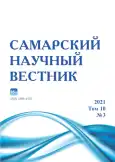Evolution of teenagers’ deviant behavior problem in writings of national and foreign authors
- Authors: Chelnokova T.A.1
-
Affiliations:
- Kazan Innovative University named after V.G. Timiryasov
- Issue: Vol 10, No 3 (2021)
- Pages: 299-302
- Section: Pedagogical Sciences
- URL: https://journals.rcsi.science/2309-4370/article/view/90508
- DOI: https://doi.org/10.17816/snv2021103318
- ID: 90508
Cite item
Full Text
Abstract
The paper presents the results of the author’s research of the basic trends in evolution of teenagers’ deviant behavior problem in writings of national and foreign authors. This topic is widely presented in scientific researches. Its methodological base originates from the works of 19 century researchers. The first-rate sociologists stand at the dawn of researches, it highlights social significance of deviant behavior problems. National researchers and representatives of psychological science contribute to the methodology of the problem. The variety of methodological and theoretical approaches to the problem of deviant behavior provides a possibility of explanation of the whole variety of deviant behavior forms. The author pays attention to some publications written on the results of conducted researches, underlining a wide ramified structure of the researches agenda. The paper also gives a brief analysis of «deviant behavior» term; it is underlined that the problems connected with it are considered by representatives of different fields of science (sociology, psychology, pedagogics, criminology, cultural studies). At the end of the paper the similarity of trends in research of the deviant behavior problem by national and foreign authors is stated. The author notes the importance of knowledge of recent researches for arrangement of work with children and teenagers in the educational system.
Full Text
##article.viewOnOriginalSite##About the authors
Tatyana Aleksandrovna Chelnokova
Kazan Innovative University named after V.G. Timiryasov
Author for correspondence.
Email: chelntat@gmail.com
doctor of pedagogical sciences, professor of Theoretic and Inclusive Pedagogics Department
Russian FederationReferences
- Стратегия развития воспитания в Российской Федерации на период до 2025 года: распоряжение Правительства Российской Федерации от 29 мая 2015 г. № 996-р [Электронный ресурс] // https://rg.ru/2015/06/08/vospitanie-dok.html.
- Превентивное прогнозирование девиантного поведения как условие духовной безопасности современной молодежи: учебник / авт.-сост. И.Ф. Шиляева. Уфа: Изд-во БГПУ, 2019. 122 с.
- Дюркгейм Э. Самоубийство: Социологический этюд / пер. с фр. М.: Мысль, 1994. 214 с.
- Комлев Ю.Ю. Теория девиантного поведения: от классических построений к модернистско-постмодернистскому синтезу // Вестник Казанского юридического института МВД России. 2011. № 4 (6). С. 3–11.
- Thompson K. What is Deviance? [Internet] // https://revisesociology.com/2020/10/28/what-is-deviance.
- Клейберг Ю.А. Психология девиантного поведения: учебник и практикум для вузов. 5-е изд., перераб. и доп. М.: Изд-во Юрайт, 2016. 290 с.
- Мертон Р.К. Социальная структура и аномия // Социология власти. 2010. № 4. С. 212–223.
- Загребин В.В. Девиантное поведение в контексте теоретического анализа // Вестник социально-политических наук. 2018. № 17. С. 9–15.
- Yahaya A., Abd Ghaffar M.N., Baharom B., Pendidikan J.A. Family atmosphere and its effects on the adolescents deviant behaviour [Internet] // https://core.ac.uk/download/pdf/11785968.pdf.
- Воробьева К.А. Особенности взаимоотношений в семье как фактор формирования девиантного поведения подростков // Семья и личность: проблемы взаимодействия. 2019. № 13. С. 19–26.
- Пигуль Г.И. Неблагополучная семья как фактор девиантного поведения подростка // Профилактика проявлений экстремизма, терроризма и деструктивного поведения в молодежной среде Дальнего Востока России: сб. науч. тр. по мат-лам всерос. науч.-практ. конф., Хабаровск, 29 нояб. – 1 дек. 2018 г. / под ред. М.П. Арутюнян. Хабаровск: Изд-во Тихоокеан. гос. ун-та, 2019. С. 260–264.
- Низамутдинов Р.А., Тарасов К.В. Девиантное поведение подростков как результат негативного психологического влияния неблагополучной семьи // Вестник КГПИ. 2012. № 1. С. 40–43.
- Ayubi S.A. The fenomenal of adolescent deviant behavior students in school at Genteng City Distric Banyuwangi East Java // IOP Conference Series: Earth and Environmental Science. 2020. Vol. 485. P. 012062. doi: 10.1088/1755-1315/485/1/012062.
- Landry M., Turner M., Vyas A., Wood S. Social media and sexual behavior among adolescents: Is there a link? // JMIR Public Health Surveill. 2017. Vol. 3(2). doi: 10.2196/publichealth.7149.
- Курбатова Е.В., Никитина Е.О. Влияние социальных сетей на формирование девиантных форм поведения у подростков // Психология и педагогика XXI века: актуальные вопросы, достижения и инновации: сб. мат-лов всерос. студ. науч.-практ. конф. / отв. ред. И.А. Ахметшина, О.А. Галстян. Орехово-Зуево: Редакционно-издательский отдел ГГТУ, 2019. С. 71–76.
- Сошникова А.А. Формы взаимодействия образовательного учреждения и семьи в профилактике девиантного поведения подростков // Проблемы развития полиэтничного региона: мат-лы всерос. науч.-практ. конф. Ставрополь: Изд-во Северо-Кавказского федерального университета, 2018. С. 191–195.
- Шульга Т.И. Жизненные планы подростков как фактор профилактики девиантного поведения // Вестник Московского государственного областного университета. Серия: Психологические науки. 2021. № 3. С. 64–75.
- Ахтян А.Г. Досуг как средство профилактики девиантного поведения подростков // Ученые записки Российского государственного социального университета. 2020. № 4 (157). С. 169–176.
- Мышева Т.П. Роль музейного искусства в профилактике девиантного поведения // Предупреждение и преодоление дезадаптации несовершеннолетних – центральная проблема социальной педагогики: сб. мат-лов 2-й всерос. науч.-практ. конф. Ростов-на-Дону, 2021. С. 221–227.
- Hawkins J.D., Lishner D. Etiology and prevention of antisocial behavior in children and adolescents // Childhood Aggression and Violence. Applied Clinical Psychology / D.H. Crowell, I.M. Evans, C.R. O’Donnell (eds). Boston: Springer, 1987. doi: 10.1007/978-1-4684-5170-2_11.
- Damron-Bell J. The development of deviant behavior in adolescents: the influence of student characteristics and school climate // Electronic Theses and Dissertations. 2011. doi: 10.18297/etd/309.
Supplementary files






